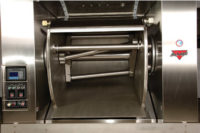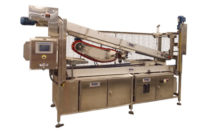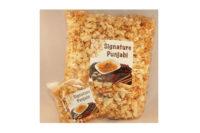At your service


















Since the 2008 economic downturn, many Americans have been closely monitoring their budgets and cutting back on or eliminating nonessential expenditures, such as eating out. For some people, weekly Friday night dinners at a favorite eatery are now monthly events, and brown-bag lunches have replaced midday trips to quick-service restaurants.
This consumer frugality may ease this year, though. According to the National Restaurant Association’s (NRA) 2013 Restaurant Industry Forecast, currently, there’s “substantial pent-up demand” for restaurant services, with two out of five consumers surveyed saying they’re not using restaurants as often as they would like.
In addition, the NRA says it expects total restaurant industry sales to exceed $660 billion in 2013, a 3.8% increase over 2012, and the fourth consecutive year of real sales growth for the industry.
Technomic Inc., a Chicago-based research and consulting firm servicing the food and foodservice industry, has an equally positive outlook for noncommercial foodservice operations in 2013. (The company defines the noncommercial segment as including colleges and universities, K-12 school districts, healthcare, retail meal solutions, convenience stores, travel centers, lodging/hotels, recreation, travel, business and industry, military, corrections, daycare, group purchasing organizations and foodservice management firms.) In a February press release, Technomic said it expects noncommercial foodservice operations as a whole to grow 3.7% this year, with the strongest growth in the healthcare (4.5%) and business and industry (4%) sub-segments. Noncommercial operations accounted for 34% of total U.S. foodservice sales in 2012, garnering more than $200 billion in sales (retail sales equivalent).
For bakers and snack producers involved in the foodservice industry, these forecasts are likely to be good news. For those who have been thinking of getting into the industry, these numbers may finally motivate them, and they will find themselves in good company.
Patience required
Jackson, Mich.-based Dawn Foods Products Inc., parent company of Dawn Foodservice, has been manufacturing baked goods for foodservice customers for 92 years. “Dawn Foodservice sells consistently high-quality bakery products to all types of foodservice customers, from national chain restaurants and independents to colleges and universities, schools, hospitals, [convenience] stores and bakeries,” says Bill McClellan, vice president of the foodservice division.
The company’s lineup includes numerous sweet baked goods, from breakfast products such as muffins, scones and pastries to snack and dessert items such as brownies, cookies and cakes. “We also offer a complete line of mixes, fillings and icings for those customers who continue to bake in-house or produce their sweet baked goods in a commissary,” McClellan adds.
Dawn Foodservice recently added a full line of round, sliced, indulgent cakes; a line of indulgent layered cakes; and Taste-fills, indulgent pastry bites available with six different fillings (apple, cinnamon, strawberry, cream cheese, cinnamon cream cheese and strawberry cream cheese). The latter line earned the company a Food and Beverage Innovation Award (FABI) from the NRA in March.
The new lines address a variety of consumer trends, including the demand for indulgent, mini desserts that offer variety; for portable and hand-held snacks and desserts; for cleaner ingredient labels; and for better-for-you products or foods perceived as being so.
“The foodservice market is a huge opportunity that represents an estimated 46% of the consumer food dollar,” says McClellan. “[However], building a foodservice business takes time and patience and is simply not a retrofit of current products and support.”
Rick Kirkpatrick, vice president of sales and marketing, Sweet Street Desserts, Reading, Pa., concurs: “The foodservice industry, in this decade, has become a fast-changing, fickle market, highly responsive to earnings reporting as well as consumer hot buttons. It takes huge commitment and determination to produce high-quality, complex desserts at the volume we do, while responding to the need for fast profitable turnaround. It takes organizational excellence to ensure that, at the end of the month, it comes together on the bottom line.”
Founded in 1979, Sweet Street’s first products were giant chocolate chip cookies, which it sold mostly to local restaurants and convenience stores. “It was clear, in those days, that Reading was too small of a market in which to open a cookie shop, so we began with the concept of baking wholesale for a much larger market—from Philadelphia to Baltimore—targeting specialty food shops and convenience stores,” explains Kirkpatrick.
Today, the company’s products are sold in more than 50 countries to numerous foodservice customers, including cafes, restaurants, caterers, hotels, colleges and universities, business and industry, sports venues, convenience stores, in-store bakeries, hospitals, airlines and cruise ships.
Sweet Street Desserts’ product line has grown considerably, too. While it still makes 5-in. chocolate chunk cookies, it now offers more than 400 different desserts, both individual and full-sized products in multiple-portion offerings. Customers can request gourmet cakes and pies, dessert bars, brownies, Pullman coffee cakes, bundt cakes, cheesecakes, gourmet cake bars, small bites, individual desserts, European desserts, petit fours, scones, parfaits and cream puffs.
“Much of the product line can be menued throughout the day, increasing margins, sales and profits for end-users,” says Kirkpatrick.
Despite its sizable product line, Sweet Street Desserts is always mindful of customer requests and consumer trends. “Because of the popularity of The Food Channel and celebrity chefs, consumers are becoming more educated and adventurous,” Kirkpatrick explains. “This affords us the opportunity to evolve our product line of cutting-edge desserts, taking risks and incorporating trendy ingredients such as Meyer lemons, goat cheese, Greek thyme honey or salted caramel.”
Kirkpatrick adds that the company is also receiving many requests for additive-free products, as consumers embrace healthy living and try to eat more “natural” products. “Operators are responding by looking for pre-portioned handcrafted desserts with intense flavors and multiple textures that are also additive-free,” he notes.
Getting real
Jay McKnight, vice president of foodservice, The Christie Cookie Co., Nashville, Tenn., also says that when it comes to cookies and dessert items, consumers want treats made with real ingredients. “Baked goods evoke memories of the comfort food you had at your grandmother’s house, using real butter, sugar, vanilla, etc.,” he explains. “Our cookies and brownies are made with clean ingredients—ingredients you can pronounce—not processed or manufactured chemically enhanced foods. They are preservative-free and have zero trans-fat. They’re also kosher-certified dairy.
“The effort we put into our baked goods, such as hand-measuring ingredients and using premium-quality chocolates, Heath toffee and real butter, is noticeable in the taste. Our customers are looking for products that have a distinctive difference, and that’s what we deliver.”
The Christie Cookie Co. started manufacturing high-quality, gourmet cookies in 1983 and began its foray into the foodservice segment in 1995, with the production of the renowned DoubleTree cookie for the Hilton hotel chain. Its foodservice division now sells cookies, gourmet brownies and muffins to leading operators in various industries, such as casual and fine dining, in-store bakery, hospitality and others. Its mail-order division also sells coffee and artisan chocolates (for more about The Christie Cookie Co., read “One Clever Cookie” in the March 2013 issue of Snack Food & Wholesale Bakery).
“We have the incredible opportunity to work with trained culinary professionals to develop wonderful recipes that take consumers taste, trends and health into consideration,” says McKnight. “We benefit tremendously from the relationships we have formed through the foodservice industry. We have a mutual trust from our collaborations together that leads to long-term relationships.”
Freeport, N.Y.-based Love and Quiches Desserts has been providing its foodservice customers with clean-label, scratch-baked products for 40 years. “We do things the same way that pastry chefs or cooks do, or that bakers do when they’re baking on their own,” says president Andy Axelrod. “We just duplicate it on a large scale, and we utilize freezing as the only preservative to get quality, wholesome products to our customers. That’s the difference.”
Love and Quiches Desserts was founded in 1973 by Axelrod’s mother, Susan, who sold quiche and desserts that she made in her kitchen to restaurants in Manhattan. “The way we grew out of New York was primarily through chain restaurants,” explains Axelrod. “The first one was Red Lobster, back when it was still a General Mills restaurant. We made its number-one selling dessert for 20 years, the Fudge Overboard, a pecan brownie. So we started with the chains early on, and they took us nationally and then internationally. We serve a lot of major corporate chain restaurants today.”
The company also sells all types of cheesecakes and layer cakes, brownies, specialty desserts, quiche and more to business and industry, university and quality regional chain restaurant customers, as well as to the U.S. military around the world. “We do a lot of customization, particularly for larger customers,” he says, adding that the company offers kosher and halal products.
“Our way is to just have top quality,” Axelrod says. “We’ll never be the least expensive—there are a lot of value-driven products out there. Our experience is that we offer something that’s a cut above and then try to partner with customers that are looking for that.”
A relative newcomer to the industry compared to the previously mentioned companies, Gagne Foods, Bath, Maine, has been manufacturing ready-to-bake frozen baked goods, including specialty biscuits, for foodservice customers for six years. “We sell our products to many types of foodservice customers, but have been most successful selling to in-store bakeries as well as retailer prepared foods departments and delis,” says Somerset Gagne, national sales director. “We also work with a lot of colleges, coffee shops and caterers.”
According to Gagne, the Gagne Foods’ Cream Cheese Biscuits are its number-one foodservice item. “Customers love the buttery, flaky layers and clean, simple ingredient label,” she says, adding the company also sells cinnamon rolls, pecan sticky buns and petite pies. “We’ve been growing our biscuit line and recently introduced two new flavors—blueberry and cheddar chive.”
Despite its relatively recent entry into foodservice, Gagne Foods stay on top of current consumer and foodservice trends. “We find that consumer demand for product without [genetically modified ingredients], trans-fats and unwelcome additives is very strong and that these consumers target certain retailers to find the products that meet this criteria,” says Gagne. “It’s good for us to be included in this mix.”
Foodservice customers, meanwhile, are requesting smaller product sizes, prompting the company to begin offering its most popular items in more sizes this year, says Gagne. Operators are also looking for baked goods to complement other elements of a meal instead of overshadowing them or filling up customers before they can try anything else.
After years of watching their budgets, consumers are ready to once again treat themselves to a weekly dinner at their favorite eatery or lunch at a restaurant near work. As a result, many restaurants, cafeterias, convenience stores and other foodservice providers will likely see their sales grow—as will their suppliers
Food(service) for thought
Analysts predict strong sales for the foodservice industry in 2013, prompting some bakers and snack producers to consider expanding into this area. Before they do, they might want to seek input from food manufacturers experienced in foodservice. The contributors to this article offer up some points to keep in mind.
First, more and more foodservice customers expect certification like the Global Food Safety Initiative (GFSI) auditing program, so you can expect to be asked if you are certified. Second, your products must be readily available via customers’ distributor/distribution channel. Third, you have to understand what your customers want and how you can serve them with a great product. But don’t try to be all things to all people. Stick with what you can do well—Jay McKnight, vice president of foodservice, The Christie Cookie Co., Nashville, Tenn.
Consider the complexity of the foodservice market. Each segment has different customer needs and requirements, with different distribution methods and so on. Build business slowly. Unlike retail, foodservice is a pallet business, not a truckload business. It takes time and the right resources, products and packaging to penetrate the foodservice market. A company must be committed to the foodservice channel, invest in the appropriate resources and have patience—Bill McClellan, vice president of the foodservice division, Dawn Food Products, Jackson, Mich.
We’ve found success by making it easy and convenient for our products to be used for both a catering event of 1,000 people or a mom-and-pop coffee shop’s Saturday morning offering. It’s true that you can’t be everything to everyone, but in the case of packaging, it helps to not exclude space-limited customers with huge cases. Smaller producers looking to expand into the industry need to be following national food-safety conversations very closely. The industry standards are changing; it can be costly to play catchup when a food-safety program needs to be audited and documented for a specific customer interested in a producer’s products. —Somerset Gagne, national sales director, Gagne Foods, Bath, Maine
Distribution is very competitive. There’s a lot of competition, so you have to find a way to differentiate your product—Andy Axelrod, Love and Quiches Desserts, Freeport, N.Y.
Ask yourself, “Do I offer an innovative difference from my competition? Do I have the production flexibility to respond to a constantly and rapidly changing market? Can I turn around a new product at lightning speed to respond to the fast-paced menu implementation?”—Rick Kirkpatrick, vice president of sales and marketing, Sweet Street Desserts, Reading, Pa.
Looking for a reprint of this article?
From high-res PDFs to custom plaques, order your copy today!















